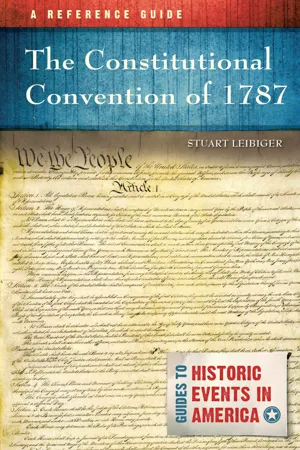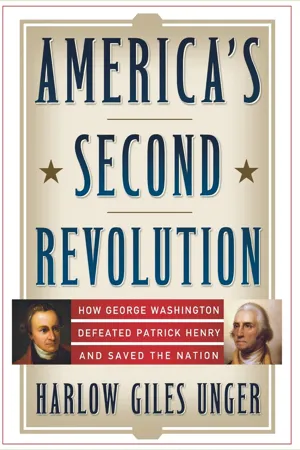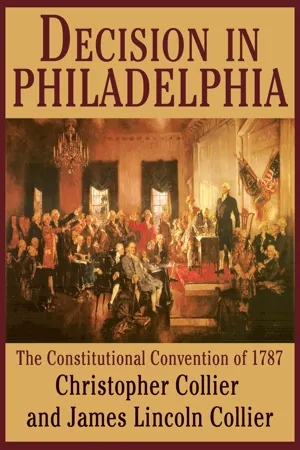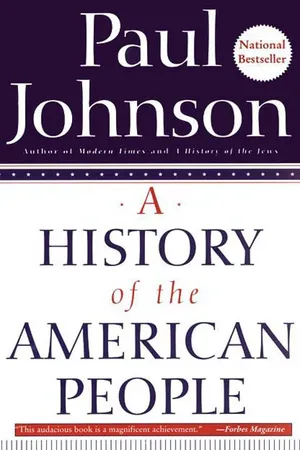History
The Great Compromise
The Great Compromise was a solution to the debate over representation in the United States Congress. It proposed a bicameral legislature with equal representation in the Senate and proportional representation in the House of Representatives. This compromise helped to establish the framework for the US government.
Written by Perlego with AI-assistance
Related key terms
4 Key excerpts on "The Great Compromise"
- eBook - ePub
The Constitutional Convention of 1787
A Reference Guide
- Stuart Leibiger(Author)
- 2019(Publication Date)
- ABC-CLIO(Publisher)
Chapter 3The Great Compromise
To counter the Virginia Plan, William Paterson, on behalf of the small states, presented the New Jersey Plan on June 15. This proposal, which conformed with Congress’s February 21, 1787, resolution, would add executive and judicial branches to the existing Confederation and give it the power to tax imports and regulate commerce. Although the one-state, one-vote system would remain, requisitions on the states for additional money would be based on population, requiring the big states to pay more taxes than the small ones. A serious proposal that would strengthen the Confederation without violating Congress’s charge to the convention, the New Jersey Plan nevertheless quickly suffered defeat, but not before making clear that the small states would settle for nothing less than state equality in one house of the legislature. The impasse over representation lasted until mid-July, when the convention passed the troublesome representation issue to a Grand Committee of a delegate from each state. Stacked with compromisers from the large states and hard liners from the small states, this committee—not surprisingly—proposed a settlement that granted the small states what they wanted. The lower house would be based on population, and the upper house would be based on state equality. The small states managed to overcome the large state-Lower South coalition and pass this Great Compromise on July 16 by a 5–4–1 vote because the Massachusetts delegation deadlocked, and the North Carolina delegation switched sides and joined the small states.The Great Compromise not only protected the interests of the small states, but it also safeguarded the states as states. Congress could pass no law without being approved by both the House of Representatives, elected by the people, and by the Senate, elected by the state legislatures.William Paterson’s parents brought him from Ireland to America at age two. He grew up in Princeton, New Jersey, where his merchant father operated a store. After graduating from his home town’s elite college in 1763, he earned a master’s degree from the same institution three years later. In college, Paterson became friends with fellow Princetonians Luther Martin and Oliver Ellsworth, both later small-state allies at the convention. Paterson did not share the wealth and aristocratic background of most of his classmates. Pierce described Paterson as “a man of great modesty, with looks that bespeak talents of no great extent.” But Pierce believed that Paterson knew exactly when and how to engage in a debate. An example of this skill came on June 15.1 - eBook - ePub
America's Second Revolution
How George Washington Defeated Patrick Henry and Saved the Nation
- Harlow Giles Unger(Author)
- 2007(Publication Date)
- Trade Paper Press(Publisher)
3
The Great Compromise
With the convention stalemated over congressional voting, Roger Sherman, the mayor of New Haven, Connecticut, proposed a compromise. The son of a farmer, Sherman had started life as a shoemaker, but “despising the lowness of his condition, he turned Almanack maker” and built an enormously prosperous mercantile enterprise that earned him enough political influence to win appointment as a judge. At sixty-six he was the second-oldest delegate after Franklin, but one of the least popular—indeed, “the oddest shaped character I ever remember to have met with,” according to Georgia’s William Pierce. “He is awkward, un-meaning, and unaccountably strange in his manner.” Pierce called Sherman’s train of thinking “deep and comprehensive,” but “the oddity of his address, the vulgarisms that accompany his public speaking and that strange New England cant . . . make everything that is connected with him grotesque and laughable.”1 Pierce and others resented Sherman’s presentation of his every idea as if it were a revelation from God:“Let voting in the lower house be proportionate to each state’s population,” Sherman suggested in his distinctive, Solomon-like tones, “and give each state parity—one vote—in the upper house. Otherwise a few large states will rule. The smaller states would never agree to [a] plan on any other principle than an equality of suffrage in this branch.”2Incredibly, the delegates voted down the former shoemaker by one vote—more, perhaps, because of personal dislike of the man than of his suggested compromise. As all sides refused to budge, New York’s Alexander Hamilton rose to call for voting by proportionate representation in both houses. His motion carried by one vote, but Elbridge Gerry of Massachusetts made it clear that the motion would not stand.Roger Sherman. A Connecticut shoemaker who built a prosperous mercantile enterprise and became a mayor and a judge, Sherman was a voice of compromise at the Constitutional Convention. - eBook - ePub
Decision in Philadelphia
The Constitutional Convention of 1787
- Christopher Collier, James Lincoln Collier(Authors)
- 2012(Publication Date)
- Blackstone Publishing(Publisher)
Tempers were rising. However, Paterson realized that if the delegates voted on the issue, proportional representation would win, and he and his small-state allies would be forced either to accept the decision or leave. He therefore moved to postpone the vote until the next session. With relief the delegates agreed, and adjourned for the day.Fortunately, the next day was Sunday, June 10. It appears that Paterson, Roger Sherman of Connecticut, and some of the other small states’ men made use of the day to meet and work out a strategy, and it is probably then that they came up with what came to be known as the Connecticut Compromise. This was a plan by which one house of the Congress would be based on proportional representation, the other on equal votes for each state.The so-called Connecticut Compromise was devised by one of the most neglected of our Founding Fathers, Roger Sherman. There is one small town at the western edge of his home state named for him, and he appears on the two-dollar bill as one of the signers of the Declaration of Independence in John Trumbull’s famous painting. Few people except students of American history know his name, and even some historians have only the vaguest idea of his importance. His role in the making of the nation was immense. Roger Sherman is the only man in our history who signed all the basic American documents. He signed the Declaration and Resolves of 1774, in which the American colonies stated their determination to resist British power, and the Association of the same year, which established the boycott of British goods. He not only signed the Declaration of Independence but was on the committee that wrote it. He was also on the committee that wrote the Articles of Confederation, which he signed; and he voted for the peace treaty with England. Finally, he would sign the Constitution. He was in the First and Second continental congresses, which organized the Revolution. He spent more time in the old Congress under the Articles than anybody else. He would be in the first United States Congress of the new government as representative, and in the second as senator.He was, moreover, no silent witness to great events but a careful reasoner and frequent speaker. At the Convention he spoke more often than anyone other than Madison and perhaps one other, depending on whose biographer does the counting. He was considered by his peers to be one of the most influential men in the country, a clever and persuasive debater who more often than not brought people around to his way of looking at issues: things tended to go his way, because he knew how to make them do so. - eBook - ePub
- Paul Johnson(Author)
- 2009(Publication Date)
- HarperCollins e-books(Publisher)
112Hence the Convention set to with a will. An analysis of the voting shows that the mechanics of compromise operated throughout—in 560 roll-calls, no state was always on the losing side, and each at times was part of the winning coalition. Broadly speaking, the Virginia Plan was adopted, and in this sense Madison can be called the author of the United States Constitution. A rather weaker version, from New Jersey, was rejected. On the other hand, the federalists, led by Hamilton, could make no real progress with their proposal for a strong central government on European lines. Amid many compromises, there were three of particular importance. In early July, the so-called Connecticut Compromise was adopted on the legislature. This gave the House of Representatives, directly elected by popular votes in the localities, the control of money Bills, and a senate, particularly charged with foreign policy and other matters, to represent the states, with two senators for each state, chosen by the individual legislatures.In August the Convention turned its attention to the knotty problem of slavery, which produced the second major compromise. The debating was complex, not to say convoluted, since the biggest slave-holder attending, George Mason, attacked the institution and especially the slave-trade. Article 1, section 9, grants Congress the power to regulate or ban the slave-trade as of January 1, 1808. On slavery itself the Northerners were prepared to compromise because they knew they had no alternative. Indeed, as one historian of slavery has put it, ‘It would have been impossible to establish a national government in the 18th century [in America] without recognising slavery in some way.’113 The convention did this in three respects. First, it omitted any condemnation of slavery. Second, it adopted Madison’s three-fifths rule, which gave the slave states the added power of counting the slaves as voters, on the basis that each slave counted, as three-fifths of a freeman, while of course refusing them the vote as such—a masterly piece of humbug in itself. Third, the words ‘slave’ and ‘slavery’ were deliberately avoided in the text. As Madison himself said (on August 25), it would be wrong ‘to admit in the Constitution the idea that there could be property in men.’114
Index pages curate the most relevant extracts from our library of academic textbooks. They’ve been created using an in-house natural language model (NLM), each adding context and meaning to key research topics.



